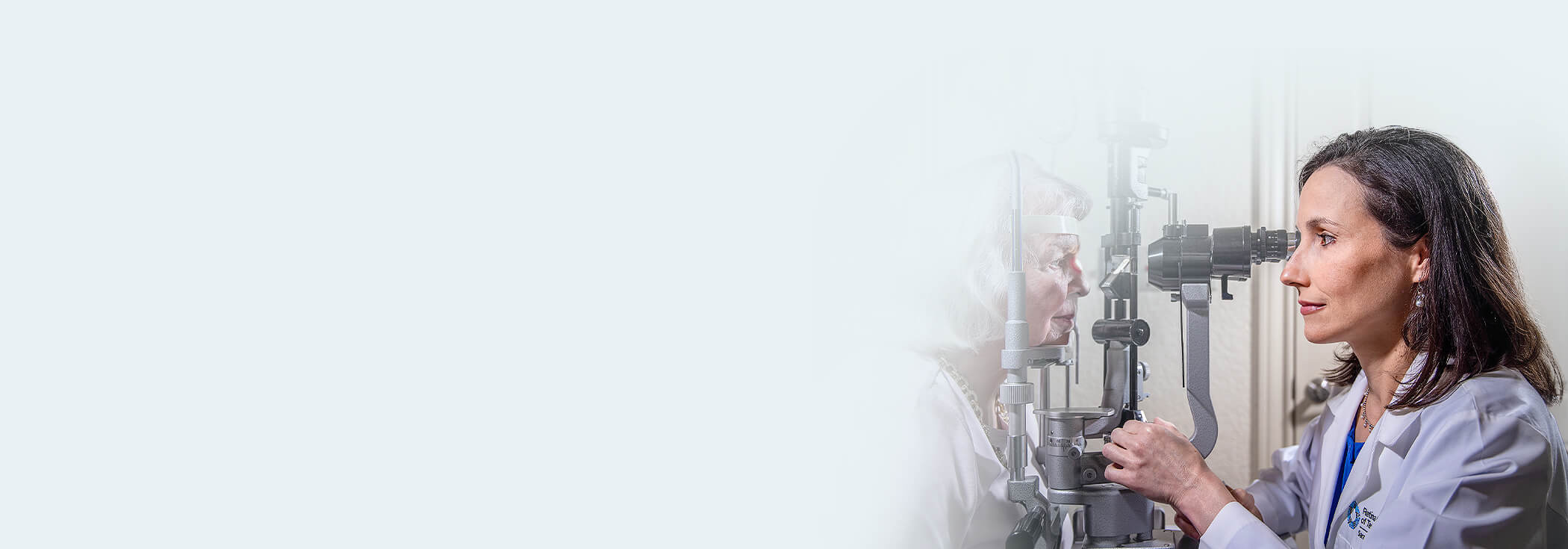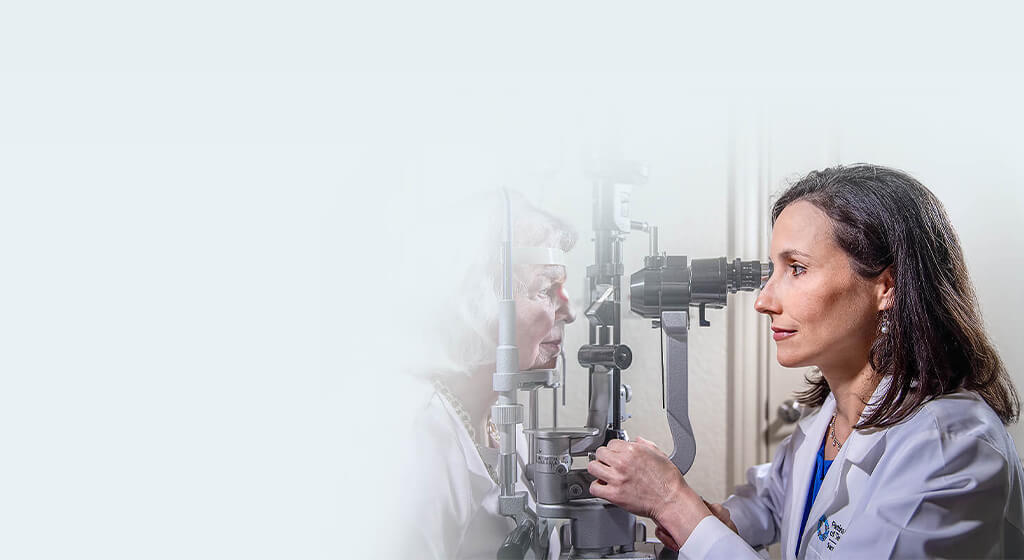At Retina Consultants of Texas, our experienced and sub-specialized physician team uses advanced technology to help detect potential retinal problems and design precise, customized treatment plans to optimize care for each of our patients.
Depending on your condition, your physician may use one or more of the following imaging and testing technologies:
- Anterior High-Resolution Ultrasound (UBM)
- Dark Adaptometry
- ERG (Electroretinography), EOG (Electrooculography) and MFERG (Multifocal Electroretinography)
- Fluorescein Angiography (FA)
- Fundus Autofluorescence
- High-Resolution Anterior Segment Optical Coherence Tomography (OCT)
- Humphrey and Goldmann Visual Field Tests
- Indocyanine Green Angiography (ICG)
- Microperimetry
- Ocular & Orbital Ultrasound
- Retinal Photography
- Spectral Domain Optical Coherence Tomography (SD-OCT) Imaging
- Spectralis Multi-Color Imaging
- Ultra-Widefield Photography and Fluorescein Angiography
Retinal Imaging Diagnostics at RCTX
Anterior High-Resolution Ultrasound (UBM)
Although ultrasound is more commonly used to evaluate the retina and optic nerve, it can also be used at higher frequencies to help evaluate some parts of the anterior or front part of the eye. Anterior high-resolution ultrasound (UBM) can be used to evaluate any abnormalities of the front of the eye, including the cornea, angle of the eye, iris, ciliary body, and lens.Dark Adaptometry
Dark adaptometry is a test to see how well you see in the dark. It is a useful test for evaluating certain hereditary or genetic retinal diseases since night vision problems are a common complaint in many of these diseases.In dark adaptometry, you will sit in a dark room for two minutes, and then you will be exposed to a bright light for several minutes. The bright light is then turned off, and you will be in total darkness once again. At this time, different intensities of dim light are introduced to you over a period of time, and the you let our technician know when you can see the light. The technician records the information as a curve on a graph and can compare it to a normal dark adaptation curve. Patients who have diseases that cause poor night vision (such as retinitis pigmentosa) are unable to see better in the dark over time.
Dark adaptometry can be used in addition to an electroretinogram/electrooculogram (ERG/EOG) in the evaluation of inherited retinal diseases.
ERG (Electroretinography), EOG (Electrooculography) and MFERG (Multifocal Electroretinography)
ERG (electroretinography) and EOG (electrooculography) measure the electrical response of the different layers and components of the retina to light and dark stimuli. These tests can help us diagnosis hereditary conditions affecting the retina such as retinitis pigmentosa or Stargardt’s disease.Multifocal ERG has been recognized as an effective test for many diseases affecting the retina, most notably retinal toxicities like chloroquine (CQ) and hydroxychloroquine (HCQ) retinopathy screening.
Fluorescein Angiography (FA)
Fluorescein angiography (FA) is a photographic study of the blood supply to your retina. Fluorescein dye is injected into the vein of your arm, and this yellow dye passes through the blood vessels in your retina. A specialized camera is then used to take digital photographs of the blood vessels. This procedure is used to diagnose many different disorders affecting the retina and is generally very safe. The dye can be used in people who are allergic to shellfish or iodine and can also be used in patients who previously had reactions to contrast dye during radiologic procedures. However, in some rare instances, the dye may cause an allergic reaction, and this will be closely monitored during the procedure. Patients who undergo fluorescein angiography may also notice that their urine is yellow or green on the day of the procedure. This is normal and should stop within a day or two.Fundus Autofluorescence
Fundus autofluorescence utilizes a blue-green wavelength light to visualize conditions that affect the pigment layer of the retina (retinal pigment epithelium). This simple, non-invasive, diagnostic test has greatly expanded our understanding and management of many different diseases affecting the macula, including dry age-related macular degeneration. Fundus autofluorescence takes only a few minutes and has no known adverse effects.High-Resolution Anterior Segment Optical Coherence Tomography (OCT)
Although optical coherence tomography (OCT) is more commonly used to evaluate the retina and optic nerve, it can also be used to visualize parts of the anterior or front part of the eye. High-resolution anterior segment OCT can help your retina physician evaluate any structures in the front of your eye, including the cornea, angle of the eye, iris, ciliary body, and lens.Humphrey and Goldmann Visual Field Tests
Certain eye diseases, such as glaucoma and retinitis pigmentosa, may cause loss of peripheral vision over time. This loss of peripheral vision can be documented and followed using visual field testing. Depending on your vision and the degree of the visual field loss, your retina doctor may recommend a Humphrey or a Goldmann visual field test.During an automated Humphrey visual field test, you are asked to look at a target straight ahead and then press a button if and when you see a light that shows up in your peripheral visual field. The computer automatically generates and prints out a copy of your visual field test.
A Goldmann visual field test is less commonly performed. It is generally used in patients who have very poor vision or advanced visual field loss. In a Goldmann visual field test, an examiner manually moves a light target of differing sizes and intensities while you look straight ahead. You let the technician know as soon as you see the target. The examiner draws or maps out the visual field while performing the test.
Indocyanine Green Angiography (ICG)
Indocyanine green angiography (ICG) is a photographic study of the blood supply to part of your retina. Indocyanine green dye is injected into a vein of your arm, and a specialized camera is used to take digital photographs of the blood vessels under the retina. This procedure can allow your doctor to study parts of your eye that are difficult to visualize with the more commonly used procedure of fluorescein angiography. It is especially useful in evaluating cases of centrel serous chorioretinopathy, certain forms of macular degeneration, and some inflammatory disorders. ICG is generally safe but has a slightly higher incidence of allergic reactions than fluorescein angiography. If you are allergic to shellfish or iodine, you should not undergo ICG testing.Microperimetry
Microperimetry allows us to measure the visual function of a specific part of the retina. Usually the test is used to measure macular function. Before the test begins, you stay in a dimly lit room for a few minutes. After this, you are asked to look straight at a target and are presented lights of varying intensity. You press a button every time a light stimulus is seen. The computer generates a map of the specific part of your retina that was tested, measuring the visual function. The microperimeter can be done along with optical coherence tomography (OCT) to objectively measure the visual function of a particular area of your retina over time.Ocular & Orbital Ultrasound
We use ocular ultrasound to evaluate the eye in circumstances where we have difficulty seeing into the eye during a dilated exam because of eyelid swelling, poor pupil dilation, corneal scarring, an advanced cataract, or a hemorrhage in the eye.Ultrasound can also be useful after a traumatic injury to the eye to evaluate a foreign body or retinal detachment. Some optic nerve findings, such as optic nerve drusen, can also be confirmed using ultrasound. Finally, ultrasound is used in the evaluation and treatment of tumors in the retina and choroid.
After anesthetic eye drops are placed in the eye, an ultrasound probe is gently positioned over it. The probe is used to transmit sound waves that travel through the eye. As these sound waves hit different parts of the eye, they are reflected back to the probe. The reflected sound waves are then transmitted into an electrical signal that is then turned into an image on a computer monitor. We can then study and even measure these images from the ultrasound.
Ultrasound is a very safe, non-invasive test that has no adverse effects and is available at all Retina Consultants of Texas offices.
Retinal Photography
Retinal photography (as well as ultra-widefield photography) utilizes a camera to take pictures of the retina in the back of the eye. The eye generally needs to be dilated to ensure we can obtain quality images. Retinal photography may be used in a variety of conditions to document findings and follow them over time. It is non-invasive, and there are no reported adverse effects.Spectral Domain Optical Coherence Tomography (SD-OCT) Imaging
Optical Coherence Tomography (OCT) is an imaging technique that utilizes light wave interferometry to produce high-resolution, cross-sectional images of the retina, similar to a computed tomography (CT) scan. The images measure the thickness of the retina and are very useful in the diagnosis and follow-up of many diseases affecting the macula. The scan takes only a few minutes and is non-invasive with no adverse effects. High-resolution spectral domain OCT testing is available at all of our Retina Consultants of Texas offices.Spectralis Multi-Color Imaging
Multi-color imaging is a new technology that enables your retina doctor to obtain higher quality photographs of the retina. This new system uses three separate laser colors, each scanning a different layer of the retina. The combined information obtained from each laser provides a sharper and clearer image than previously possible. An advantage of using this technique is that quality photographs can be obtained even in difficult-to-image patients such as those with advanced cataracts or eye movement disorders.Ultra-Widefield Photography and Fluorescein Angiography
Classic retinal photography and angiography usually covers only about 45 degrees or roughly 20 percent of the retina at one time. Many abnormalities of the peripheral retina are difficult to image during fluorescein angiography (FA), and therefore, we are unable to thoroughly evaluate it. However, with ultra-widefield photography, we are able to view a much larger portion of the retina in one image.Ultra-widefield imaging allows us to view almost 200 degrees or 80 percent of the retina at one time. Fluorescein angiography (FA) can also be done using ultra-widefield photography, and it provides superior visibility of the peripheral retina. Many abnormalities in the peripheral retina that were previously unable to be viewed on traditional angiography are demonstrated clearly on wide-field imaging[1] (Witmer et al. 2013). However, it is important to note that ultra-widefield photography, or any photography for that matter, does not take the place of a good, dilated eye exam by your ophthalmologist.
Most of our Retina Consultants of Texas offices are equipped with instruments that allow ultra-widefield photography and fluorescein angiography (FA).
- Witmer MT, Parlitsis G, Patel S, Kiss S. Comparison of ultra-widefield fluorescein angiography with the Heidelberg Spectralis(®) noncontact ultra-widefield module versus the Optos(®) Optomap(®). Clin Ophthalmol. 2013;7:389-94. pubmed.ncbi.nlm.nih.gov/23458976
Visit Retina Consultants of Texas for Diagnostic Testing in Houston and San Antonio
At Retina Consultants of Texas, preserving your vision is our mission. We offer a full spectrum of retinal care using the most advanced technologies to address diseases of the retina, macula, and vitreous. For world-class retinal care, including diagnostic testing, schedule an appointment with RCTX in the Greater Houston and Greater San Antonio, TX areas today.


